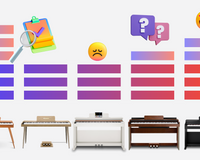Acoustic Guitar Lesson for Beginners
According to statistics, acoustic guitar is the first instrument want to learn for most of Donner customers. Acoustic guitar is a pretty good choice for beginners because it is easy to learn, and you can play a lot of songs you like by practicing basic chords. Here, Donner takes the right-hand acoustic guitar as an example to show you the basic introductory teaching and precautions of learning acoustic guitars with beginners. Please follow the tutorial and learn it now!
Step 1: The name of guitar strings
A. Vertical lines=Strings of the guitar
The very top string closest to you is E string. And it goes E A D G B e.
B. Horizontal lines=frets of the guitar
The neck of your guitar, these metal bars throughout the neck those are called your frets.

Note: Don’t put your fingers directly on these metal bars on these frets, It’s correct to put your fingers behind them.

Step 2: Make sure it’s in tune
A tuner is included in Donner acoustic guitar package, you can use the tuner to make strings in tune.
You can also download apps to help tune your guitar like Donner Music app. There are many free and downloadable applications.
You have your app open and you pluck that string, it will tell you whether you are too high or too low, and turn your tuning pegs left or right to tighten or loosen your strings.
Go to have a try!

Step 3. How to read chords
Chord is the most essential skills for very guitar player. Do you know how to read a chord and how to put your hand on the guitar?
1.Not all strings are played for every chord
String with an X is don’t play
Strings with an O is play open(no fingers on that string)
Dots with number are where to place fingers

These numbers refers to the fingers on your hand,
Your index finger is number one
Your middle finger is number two
Your ring finger is number three
Your pinky is number four
2.Use the above way to read the chord
G, Dsus4, Em7 and Caad9 chord, which are the basic and commonly used chords for beginners.

Step 4: Guitar exercises for beginners
Practice basic chords and their transitions
A. The secret to learn faster for you:
Use a Mechanical Metronome or check the description for some metronome apps.

It helps you keep time kind of like how you might tap your foot to a song while you’re listening to it. You can choose what speed you want to go and this is the secret ingredient to what’s going to help you learn guitar faster.
B. Practice transitions of these chords until you can play them smoothly at your “just right” speed! (It will be comfortable for you to practice these transitions until you can play them back and forth at 60 beats per minute on your metronome.)



NOTE:
A little finger tip pain is completely NORMAL when learning guitar
1. How to deal with finer pain?
Use the pad of your finer×
Use the tip of your finger√

Remember to arch your fingers so they’re more curved instead of playing them flat
2. Build your calluses
-exercise about a month
-shorter sessions multiple times
-maintain short fingernails
-know your limits
-use rubbing alcohol on fingertips
3. Change your strings
-Nylon strings hurt the least
-Lighter gauge strings are easier to press down
-Thicker strings build calluses faster
4. Use right pressure
Pressing too hard=change note
Pressing lightly=cause buzzing
Step 5: Choose the right acoustic guitar for your learning
Advice on choosing an acoustic guitar for beginners:
Material: Plywood Guitar/Single-Board Guitar
Plywood: Plywood is a multi-layer laminated plate, the transmission of vibration between different media will have a great degree of loss, so the vibration from the string will be rapidly weakened after it is transmitted to the board surface. By the time it reaches the resonance box, it has been weakened a lot, so the sound volume is not as good as that of a single board, but the price is cheaper than the single-board one.
Single board: Each frequency band of the single board is very balanced, and it can make each string play a delicate tone. The layers of each string can be well blended together when strumming, but each string can still be heard. They are all working in their "posts",while plywood is often mixed. Single-board guitar has a good sustain effect and is suitable for beginners.
Size: Ordinary acoustic guitar sizes are generally 36, 40, 41 inches, etc.
The larger the size, the better the resonance and the better the tone. But it's not that bigger is better, different heights choose different sizes. How to choose the right size for you?
Here are some commonly used sizes corresponding to heights for your reference:
<150CM : suitable for a 36-inch or smaller guitar
150CM-160CM : suitable for 39, 40 inch guitars
160CM-170CM : suitable for 40, 41 inch guitars
Above 170CM-180CM : choose a 41-inch or larger guitar
Acoustic guitar for beginners:
| <150cm | 150cm-160cm | 160cm-170cm | above 170cm-180cm | |
|
Reference Size |
36 inch | 40 inch | 40 / 41 inch | 41 inch |
| Guitar |

|
 |
 |
 |
More acoustic guitar for your reference
Keep on going with Donner!







































